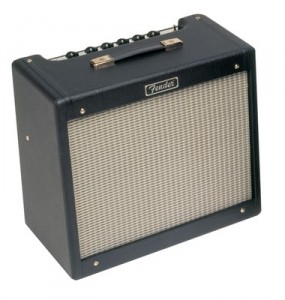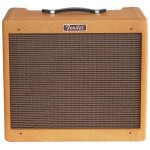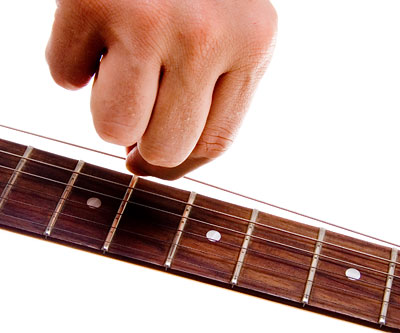To decide which guitar strings to use, I usually look past brand. More important are the gauges, and materials used to make the strings. Continue reading Which Guitar Strings to Use?
Tag: fender
Fender Blues Junior Amp Review
 I’ve had the pleasure of playing many Fender Blues Juniors over the years, and I must say, its a nice little amp. At 15 watts, this amp is loud! If you are playing blues, you can definitely get some nice tones from the Blues Junior. And with the onboard reverb, and fat switch, finding a likable tone is easy. Lets take a closer lookat the Fender Blues Junior, and how you can make this amp sing!
I’ve had the pleasure of playing many Fender Blues Juniors over the years, and I must say, its a nice little amp. At 15 watts, this amp is loud! If you are playing blues, you can definitely get some nice tones from the Blues Junior. And with the onboard reverb, and fat switch, finding a likable tone is easy. Lets take a closer lookat the Fender Blues Junior, and how you can make this amp sing!
A good thing about this amp is the Master Volume. Being a vintage guy, I really like to crank an amp to get great tone. But since this amp is small enough, the MV makes it very usable in a bedroom setting. If you want some good overdriven tones at lower volume so you don’t piss off the neighbors, this function is extremely useful. As well, sometimes you want great tone, without blowing your own ears off. Very tweakable in this sense.
 Now I’ve played a few different kinds of blues juniors. Some versions that had tweed and red tolex. The difference on the inside was the speaker used, and the kinds of tubes. This makes the stock blues junior a great DIY style amp, as you can choose your own speaker/tube preferences to customize the tone to you. Some of the speakers used on these versions are Eminence, Jensen, and Celestion.
Now I’ve played a few different kinds of blues juniors. Some versions that had tweed and red tolex. The difference on the inside was the speaker used, and the kinds of tubes. This makes the stock blues junior a great DIY style amp, as you can choose your own speaker/tube preferences to customize the tone to you. Some of the speakers used on these versions are Eminence, Jensen, and Celestion.
 Great EQ on this amp with a middle, bass, treble and fat switch. I like using the fat switch with my strat, as it really gets a great blues tone.
Great EQ on this amp with a middle, bass, treble and fat switch. I like using the fat switch with my strat, as it really gets a great blues tone.
I found with the Blues Junior that I was able to get sounds for most genres of music, aside from say metal.
All I can say is that if you are playing small bars, or just playing in your apartment, this is a great amp. View the Blues Junior on Amazon.
Fender Standard Stratocaster Review
 As one of the most famous electric guitars of all time, the Fender Stratocaster does it all. With 3 single coil pickups, strats can give you some smooth blues to a country twang. You can find this guitar in literally any genre. Lets take a closer look..
As one of the most famous electric guitars of all time, the Fender Stratocaster does it all. With 3 single coil pickups, strats can give you some smooth blues to a country twang. You can find this guitar in literally any genre. Lets take a closer look..
Used by some of the greats such as Jimi Hendrix, Stevie Ray Vaughan, and Eric Clapton, many are fully aware of the Strat’s ability to be a rocking blues machine. And the best part of this guitar is that it allows your characteristics to come through in your playing, whereas a guitar with humbucking pickups (such as a Gibson Les Paul) tend to sound similar from player to player.
The Stratocaster is equipped with one volume and two tone controls. One set controls the neck pickup, and the other set controls the middle pickup. Along with these controls comes a 5-way pickup selector. You can either play each pickup separately or team up the middle pickup with either the bridge or neck pickup. You’ll see a lot of mods online to be able to use the bridge and neck pickup together.
The majority of strats are made of alder in the body, and the neck is usually maple with either a rosewood or maple fret board. There has always been a big debate as to which fretboard wood is better. Simply put, some people prefer rosewood and others prefer maple. Maple is said to have a bit of a brighter sound. You’ll notice that in the last two years of Jimi Hendrix’s life, he primarily used 2 strats, both with maple boards.
If you want to make the best of your strat tone, then you should run it through a tube amp. Strats tend to pair up well with Marshall amps, particularly the Marshall Plexi, equipped with at least a 4×12 cab. You’ll see Hendrix rocking a row of 100w Plexis in live situations. But, we can’t forget how well strats pair with Fender Amps. Many consider blackfaced fender amps from the 60s to be some of the greatest amps of all time. I personally like a Fender Deluxe Reverb, or a Vibrolux Reverb. Once you have found your desired amp, the secret to getting amazing tone, is to crank the amp up. That means a whole lot of volume. The reason being is that it gets the tubes nice and hot and adds a lot of natural harmonics to your tone. If you are playing in an apartment or somewhere that can bother your neighbours, you may want to consider a Fender Champ coming in at 5 watts. These amps still give unbelievable tones when cranked.
All I can say is that the Fender Stratocaster is probably my favorite electric guitars, and as a blues player, it gives me that elusive tone I’ve been looking for. If you haven’t already, run to your local music store to play one. You won’t regret it! View the Fender American Standard Stratocaster on Amazon.
Fender Standard Jazz Bass Review
 I recently purchased a Fender Jazz Bass while at a store comparing bass tones. It was evident right away that its tones was the most transparent, that is to say, you could clearly hear each note. Its dynamics were almost reminiscent of a strat. I knew this was the Bass for me when playing some blues lines.
I recently purchased a Fender Jazz Bass while at a store comparing bass tones. It was evident right away that its tones was the most transparent, that is to say, you could clearly hear each note. Its dynamics were almost reminiscent of a strat. I knew this was the Bass for me when playing some blues lines.
I turned the amp up pretty loud to push the tubes a bit. It really made this guitar sound alive. If you want amazing bass tone, I highly recommend a tube amp, especially for this guitar. It really gives a 3-dimensional sound.
Not only does the Jazz Bass cater to alot to famous blues and jazz players, you’ll also see this guitar in a heavier setting. Jimi Hendrix, said to be one of the loudest guitar players ever, was accompanied by Billy Cox in 1969/70 to join his band and tour. You can hear some live stuff on youtube, particularly at the isle of wight in 1970. Cox used the Jazz Bass predominantly with hendrix, and his funky, soulful playing really vibrated well with the Jazz Bass.
My current set up with my Jazz Bass is running through a 70s’ Traynor BassMate equipped with EL-84 power tubes. Again, if you want to make the most of this guitar, or any guitar, get a nice tube amp. When those tubes get hot, the tone is unbelievable. .
All I can say is, if you are into blues, jazz, rock, or whatever really, try out the Fender Jazz Bass. It’ll bring life to your sound. View the Fender American Jazz Bass on Amazon.
How to get Jimi Hendrix Tone
When it comes to tone, Jimi Hendrix never fails to amaze me. Of course his guitar playing is light-years beyond any human form, and top it off, even his tone is untouchable. With his rig, he was able to project a harmonically-rich, monstrous roar that was so elusive, so mind-boggling, yet very pure and organic. His rig gave him the dynamic to be able to tell a story with his amazing skill. The components of his rig allowed him to express himself deeply, whether he wanted to make his guitar sing, laugh, cry, scream, or whisper. With all of this dynamic, Jimi could take us on a trip, describing the ways of the universe, enlightening our souls with pure energy. No one will ever be able to do what Jimi did. But wouldn’t it be great to come close? Wouldn’t it at least be awesome to get some of those great tones that he got?
Well lets start with the basics. First the guitar: it should be a Fender Stratocaster, with three single coil pickups. These pickups should be low-output as that’s how they were in the late 60s’ and play a big role in the tone equation. There are some good copies on the market that’ll do better than a lot of Fender Strats produced today. If you can get your hands on an 80s’ made in Japan Tokai Strat, you’ll get a really well crafted guitar, a lot having the 60s’ specs. Jimi’s guitars were coated with nitrocellulose which some say allow the guitar to breathe better then today’s poly finish. In the last two years of Jimi’s short life, he primarily used a black and a white strat, both with maple necks. Also he typically used light strings (10-38) tuned down a half step (Eb), allowing him to bend notes with total ease.
On to the Amp: its gotta be a 100-watt superlead, superbass, or jtm45/100 with at least 1 4X12 cab. The 100-watters offer a lot more headroom, and the cab will make for a bigger sound. The amp power tubes can be KT-66s, EL-34s, or 6550s. Two great amp makers that specialize in building these plexi style amps from the late 60s are MetroAmp and Germino. Both excellent brands that go the extra step to nail that vintage tone. Don’t forget about the speakers in the cab; they are very important in achieving the sound. Jimi used Celestions, a very good brand. However, currently they don’t make the same speakers today that they once did. Scumback is great brand of for getting vintage spec speakers. Finally, you will realize that a 100-watt stack will blow your ears off. Consider getting a PPI Master Volume installed, or look into purchasing an attenuator. This is crucial since cranking the amp is part of getting the tone, and getting into pure tube saturation.
Lets talk about Effects: Hendrix used a wah, univibe, fuzz, and octave in a live setting. I’m sure most of you know what these pedals do, so I won’t go into it too much, but I will recommend some brands. Most mass produced pedals on the market today do not replicate the pedals used in the 60s/70s, and even worse, a ton of them are digital! So to get closer to the tone, you’ll want to look into boutique pedals. For the wah, the Real McCoy Teese Picture Wah is said to be the closest. For univibe, an original shin-ei would be amazing, and incredibly expensive. So the Megavibe by KR, and Aquavibe by Foxrox are fantastic. For the Fuzz pedal, Roger Mayer Axis Fuzz and KR’s Gypsy Fuzz are very expressive. Here’s more on Hendrix Fuzz Pedals. And for the octave, the Chicago Iron Octavia is a favorite of Hendrix enthusiasts. Finally, the cables used also are also a piece of the puzzle. Jimi used coily cables that are said to smooth out the treble a bit.
Now go out there, hook everything up, crank the fuzz and control it with your volume knob to go between clean and fuzz tones, and start exploring the world of great tones. You’ll find that there really are endless amounts of different tones you can get with a little tweaking. Enjoy!

